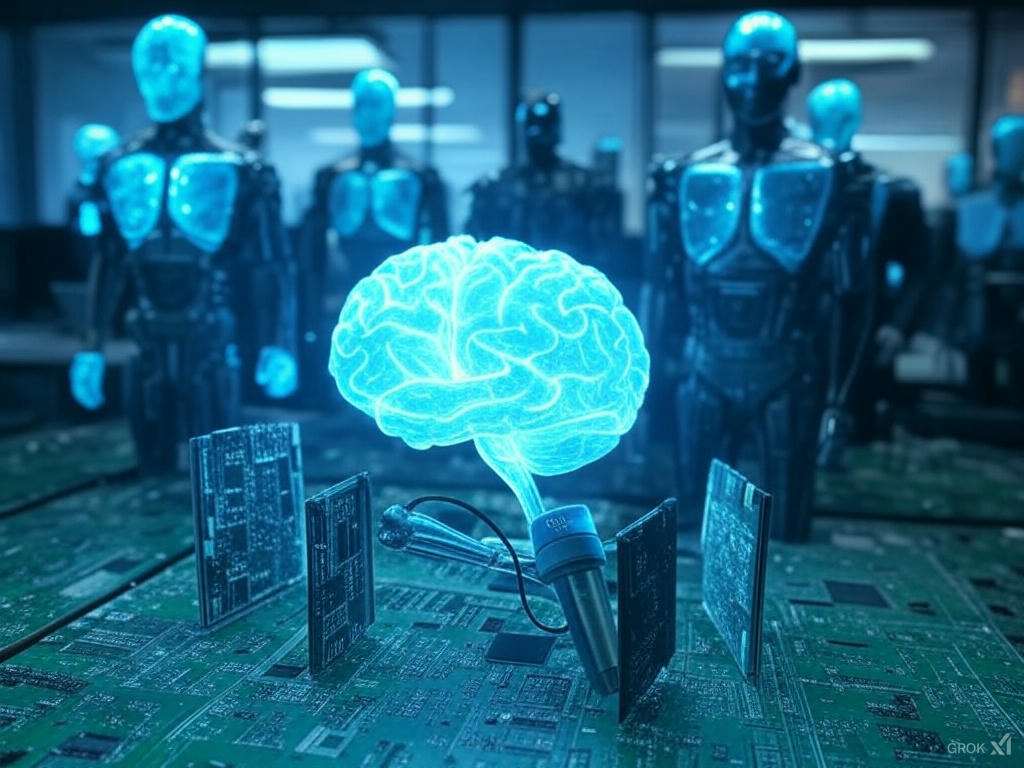Picture this: a small Chinese startup, barely a blip on the global tech radar, takes on the giants of the American tech industry and sends shockwaves through the world of science, business, and power politics. You will not have seen a greater demonstration of defeating the hard power of technology with intelligent math. That’s exactly what DeepSeek, a Chinese AI company, has done with its groundbreaking model “R-1.” In a stroke of pure genius, it’s managed to outsmart U.S. sanctions and rival the powerful tech engines of Silicon Valley—not with brute force, but with clever innovation. But as the dust settles, questions swirl: Has China stolen America’s thunder? Has it overtaken the U.S. in the AI race? And what does this mean for the future of technology? Let’s dive into this fascinating story and unpack the stakes in the chip race between China and the USA.
The Genius of DeepSeek: A Game-Changer Emerges
DeepSeek’s rise is nothing short of extraordinary. Launched in May 2023 by a 37-year-old entrepreneur, Liang Wenfeng, this low-cost AI startup started with just a couple hundred employees and a modest vision. Fast forward to January 2025, when DeepSeek dropped a bombshell: its “R-1” model, a thinking and reasoning AI built for a mere $6 million. To put that in perspective, American tech titans like Meta have poured $60 million into similar upgrades for models like Llama 3, with plans to spend $60 billion more to stay ahead. OpenAI, the maker of ChatGPT, has spent years and billions chasing the same capabilities. DeepSeek? It did it in two months, using just 2,000 older Nvidia chips compared to the 16,000 supercomputer chips Meta relies on. The result? A model that competes head-to-head with the best in the business—at a fraction of the cost.
This isn’t just a win for DeepSeek; it’s a wake-up call for the world. The U.S. has spent two decades erecting walls to keep China from catching up in cutting-edge tech, particularly in artificial intelligence (AI) and the semiconductor chips that power it. Yet here we are, watching those efforts backfire spectacularly. On the very day President Donald Trump took his oath in January 2025, DeepSeek unveiled R-1, shaking the confidence of American companies and investors alike. Nvidia, the darling of the AI chip world, lost $900 billion in market value in a single day—equivalent to two and a half years of Pakistan’s GDP. Why? Because DeepSeek’s success challenges the assumption that only massive computing power and billions of dollars can win the AI race.
The Sanctions Saga: America’s Strategy Unravels
To understand how we got here, let’s rewind to October 7, 2022. That’s when the U.S. government, under President Joe Biden, slapped sweeping sanctions on Chinese tech companies, banning global nanochip makers from selling cutting-edge tech to China. These weren’t just any sanctions—they targeted companies worldwide, American or not, that relied on U.S. technology or assistance. The goal? Cripple China’s ability to compete in AI by cutting off its access to the powerful processors that drive it. Over the past 20 years, the U.S. has imposed over 1,000 direct and indirect sanctions on China’s IT industry, with 532 aimed squarely at Chinese firms and the rest hitting global trade agencies that might help China get modern chip tech.
This wasn’t a one-off move. Every U.S. president has flexed their muscle against China’s tech ambitions. Before losing the 2020 election, Donald Trump blacklisted China’s key semiconductor companies. In December 2024, just before the polls, Biden’s administration piled on more restrictions. The U.S. has been desperate to keep its tech giants—Apple, Google, Microsoft, Nvidia, and OpenAI—ahead in the AI race, no matter how much power it takes. Why? Because AI is the future, and quantum computing, built on advanced semiconductor chips, is its backbone. Without powerful processors, you can’t process massive data sets at lightning speed—a must for everything from fighter jets to self-driving cars.
In 2022 alone, China spent more on importing semiconductors than oil, a sign of how critical these chips are to its ambitions. The U.S. thought it could choke that supply line, leveraging its control over Taiwan’s TSMC (Taiwan Semiconductor Manufacturing Company), which produces 90% of the world’s advanced chips, down to 2 and 3 nanometers. TSMC powers everything from Apple’s MacBooks to Nvidia’s graphics cards, and despite being a stone’s throw from China, it’s firmly under U.S. influence. Samsung in South Korea and Dutch firms play a role too, but none match TSMC’s dominance—and the U.S. has banned them from dealing with China as well.
The Power of Processors: A Nanometer Revolution
So, what’s the big deal with these nanochips? Let’s break it down. Processors, made from semiconductor materials, are packed with tiny circuits called transistors—the more transistors, the more powerful the chip. Back in 1971, Intel’s first microprocessor had 2,300 transistors. By 2000, the Pentium 4 boasted 42 million. Fast forward to 2020, and Apple’s M1 MacBook Air rocked 16 billion transistors. Last year’s M4 MacBook? 28 billion. Nvidia’s latest AI chips? A staggering 80 billion. These numbers are mind-boggling, and the smaller the transistors, the more you can cram into a chip.
Here’s where nanometers come in. A 3-nanometer chip doesn’t mean every transistor is exactly 3nm, but it’s a measure of how densely they’re packed—up to 300 million in a square millimeter. Compare that to the 200,000-nanometer thickness of an HB pencil line, and you’ll see why making a 3nm chip is a bigger leap than landing a man on the moon. It’s cutting-edge tech, the bedrock of innovation in AI, medicine, manufacturing—you name it. Without it, you’re stuck in the past, unable to compete in a world where machines can read 10 billion pages in a second and spit out answers.
China’s Counterpunch: Wisdom Over Might
The U.S. thought it had China cornered by denying it these tiny powerhouses. But China had a secret weapon: wisdom. DeepSeek couldn’t get the latest 3nm chips, so it turned to older 7nm processors—less powerful, slower, but still workable. Instead of relying on raw computing muscle, its engineers wrote algorithms so efficient they squeezed every ounce of performance out of those old chips. It’s like being banned from buying a hammer to break rocks, so you invent a way to soften the stone with your hands—and end up with a masterpiece that stuns everyone.
Before last Christmas, DeepSeek rolled out its V3 model, a ChatGPT rival that matched its speed with far less tech. Most U.S. firms brushed it off—Meta, OpenAI, and Microsoft were busy cooking up their next big thing, a reasoning AI dubbed the “3O” model by ChatGPT. They figured China couldn’t touch them without top-tier chips. They were wrong. R-1 didn’t just compute—it reasoned, rivaling OpenAI’s best at a tenth of the cost. And here’s the kicker: China made it open-source and free. Anyone can download it, tweak it, and run it offline on their own servers. Compare that to Apple’s locked-down iOS or OpenAI’s guarded models, and you see why this is a game-changer.
The Fallout: Investors Reeling, Accusations Flying
The impact was immediate. Investors who’d sunk billions into U.S. AI startups started questioning their bets. Why pour money into Nvidia or OpenAI when a Chinese startup could deliver similar results for peanuts? Nvidia’s $900 billion single-day loss wasn’t just a financial hit—it was a signal that the paradigm had shifted. Meanwhile, OpenAI cried foul, alleging in the Financial Times that DeepSeek stole its models—an “intellectual property breach.” Is that true? Maybe. R-1 does resemble ChatGPT, built on open-source models DeepSeek refined. But here’s the rub: those models were already out there, legally accessible for $270 a pop. DeepSeek just took them further—and gave them away for free.
In the tech world, innovation trumps accusations every time. Once an idea hits the market, it’s fair game—think atomic bombs or jet engines. The U.S. can complain, but the world will buy what’s cheap, efficient, and available. DeepSeek’s open-source gamble could capture global markets if American firms don’t adapt. If they lock their tech down, China wins. If they open up, China learns and leaps ahead. It’s a no-win scenario for Silicon Valley.
China vs. USA: Who’s Ahead?
So, does this mean China has overtaken America? Not quite. The U.S. still leads in quantum physics and raw computing power, with TSMC and Nvidia as its aces. OpenAI’s “3O” model, still under wraps, might blow R-1 out of the water. But DeepSeek’s feat proves the U.S. can’t rely on sanctions to hold China back. After 20 years of walls, China’s engineers found a way around them, turning restrictions into a catalyst for ingenuity. Eight out of ten AI research papers now come from Chinese students or institutions—a talent pool driving breakthroughs like R-1.
Here’s a snapshot of the players in this chip race:
| Company | Model | Cost to Develop | Chips Used | Transistors | Key Feature |
|---|---|---|---|---|---|
| DeepSeek (China) | R-1 | $6 million | 2,000 (7nm) | Unknown | Open-source, reasoning |
| OpenAI (USA) | ChatGPT 3O | Billions | Thousands | Unknown | Reasoning (unreleased) |
| Meta (USA) | Llama 3 | $60 million | 16,000 | Unknown | Advanced language model |
| Nvidia (USA) | AI Chips | N/A | N/A | 80 billion | Industry-leading chips |
| Apple (USA) | M4 MacBook | N/A | N/A | 28 billion | Consumer tech powerhouse |
DeepSeek’s edge? Efficiency and accessibility. The U.S.’s strength? Scale and resources. The race is neck-and-neck, with both sides pushing their youth to master quantum physics, math, and AI.
The Bigger Picture: A Global Tech Tug-of-War
This isn’t just about chips—it’s about the future. AI will shape everything from healthcare to warfare, and the nation that master’s it holds the keys to power. The U.S. wants its giants to stay ahead, no matter the cost. China’s betting on brains over brawn, proving it can do more with less. For now, DeepSeek’s shaken the board, but the game’s far from over. Investors, policymakers, and engineers are watching closely, weighing profitability in U.S. firms against the allure of Chinese startups.
As for the rest of us? We’re not sitting idle either. While China and America race to process a billion data points in a nanosecond, some are perfecting the art of outdoing each other in less tangible ways—ego, rivalry, and all. But in the end, it’s the tech that matters. DeepSeek’s shown that wisdom can outshine might, and that’s a lesson neither side will forget anytime soon. Long live the competition—and the innovations it sparks.



